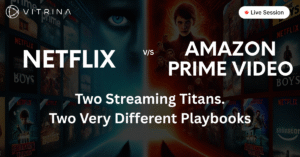Introduction
When a global TV format like The Voice, Survivor, or Who Wants to Be a Millionaire? is adapted for a new market, it undergoes a fascinating transformation to align with local tastes, cultures, and viewing habits. But what exactly happens behind the scenes of Local Version Development?
In this article, we’ll break down:
✅ What Local Version Development is and why it’s essential for global TV success.
✅ The step-by-step process of adapting a show for different regions.
✅ Key challenges in localization and how networks overcome them.
✅ How Vitrina helps production companies, distributors, and networks streamline the process.
Whether you’re a content producer, broadcaster, or distributor looking to expand internationally, this guide will give you deep insights into how global TV formats are tailored for new audiences. Let’s dive in!
Table of content
- Introduction
- What is Local Version Development?
- Why Localizing TV Formats Matters
- Key Elements of Local Version Development
- Steps to Adapting a Global TV Format
- Challenges in Local Version Development
- Successful Examples of Local TV Adaptations
- How Vitrina Helps with Local Version Development
- Key Takeaways
- FAQs
Find the Best Local Adaptation Partners

What is Local Version Development?
Local Version Development (LVD) is the process of adapting an international TV format to fit the culture, language, and entertainment preferences of a specific region. It involves changes in:
- Language (dubbed or remade in the local language)
- Cultural references (replacing jokes, traditions, or idioms to resonate with local audiences)
- Production design (adjusting set designs, locations, and visuals to match local aesthetics)
- Contestants and hosts (casting familiar local figures to create stronger audience connections)
This process ensures that the core appeal of a show remains intact while making it feel native to the target market.
Why Localizing TV Formats Matters
Global entertainment companies invest heavily in adapting formats for different markets. Here’s why:
🎯 Cultural Relevance: A direct import of a show may not resonate with local audiences. Adapting formats ensures relatability.
📺 Regulatory Compliance: Many regions have broadcast laws requiring a percentage of locally produced content.
💰 Monetization & Ratings: A localized version typically attracts more viewers and advertisers than a foreign-language import.
🌎 Market Expansion: Networks and production houses can maximize ROI by repackaging successful formats for multiple markets.
Key Elements of Local Version Development
Adapting a TV format successfully requires focusing on key aspects:
1. Script and Storyline Adjustments
- Modifying humor, dialogues, and references to align with the local culture.
2. Casting & Talent Selection
- Choosing hosts, actors, and contestants who are recognizable in the target country.
3. Visual and Set Design
- Adjusting studio or set designs to match local aesthetics and production capabilities.
4. Production & Direction Style
- Some markets prefer faster-paced editing, while others lean towards more narrative-driven storytelling.
5. Music and Sound Design
- Tailoring theme music, background scores, and sound effects to resonate with local audiences.
Track Every Global TV Format with Vitrina

Steps to Adapting a Global TV Format
1. Research & Market Analysis
- Understanding audience preferences, competitors, and cultural nuances.
2. Securing Licensing Rights
- Negotiating with rights holders and ensuring compliance with IP regulations.
3. Creative Adaptation & Localization
- Rewriting scripts, tweaking storylines, and designing new elements.
4. Casting & Pre-Production
- Selecting the right talent and setting up logistics.
5. Filming & Post-Production
- Shooting localized content and refining it for broadcast.
6. Test Screenings & Marketing
- Gathering audience feedback before launching and tailoring promotions.
Challenges in Local Version Development
📉 Balancing Authenticity & Innovation: Too much deviation from the original can alienate fans, while too little can feel unoriginal.
🔍 Cultural Sensitivities: Misinterpretations or inappropriate references can lead to backlash.
💰 Budget Constraints: Recreating high-production shows at local budgets can be challenging.
🎭 Casting Challenges: Finding the right talent to resonate with local audiences.
📊 Regulatory Hurdles: Different regions have strict broadcasting and content regulations.
Successful Examples of Local TV Adaptations
✅ The Office (UK → US) – Adjusted humor and workplace culture for American audiences.
✅ The Masked Singer (South Korea → Global) – Expanded with culturally relevant celebrity contestants.
✅ Big Brother (Netherlands → Worldwide) – Tailored house rules, challenges, and contestant interactions per country.
✅ Got Talent Franchise (UK → 70+ Countries) – Each region features judges and acts that cater to local entertainment preferences.
How Vitrina Helps with Local Version Development
🔹 Find the Right Partners: Identify production houses, distributors, and localization experts in 100+ markets.
🔹 Track Global Adaptations: Access real-time data on TV formats being localized worldwide.
🔹 Connect with Decision-Makers: Get verified contact details of key executives in content licensing, production, and distribution.
🔹 Competitive Intelligence: Monitor what major networks are adapting and where opportunities exist.
With Vitrina, expanding globally becomes seamless. 🚀
Key Takeaways
✅ Local Version Development is crucial for making global formats successful in new markets.
✅ Cultural, regulatory, and audience preferences must be carefully balanced.
✅ Successful adaptations consider language, casting, and production style.
✅ Vitrina simplifies the process by connecting businesses with the right partners and insights.



























































